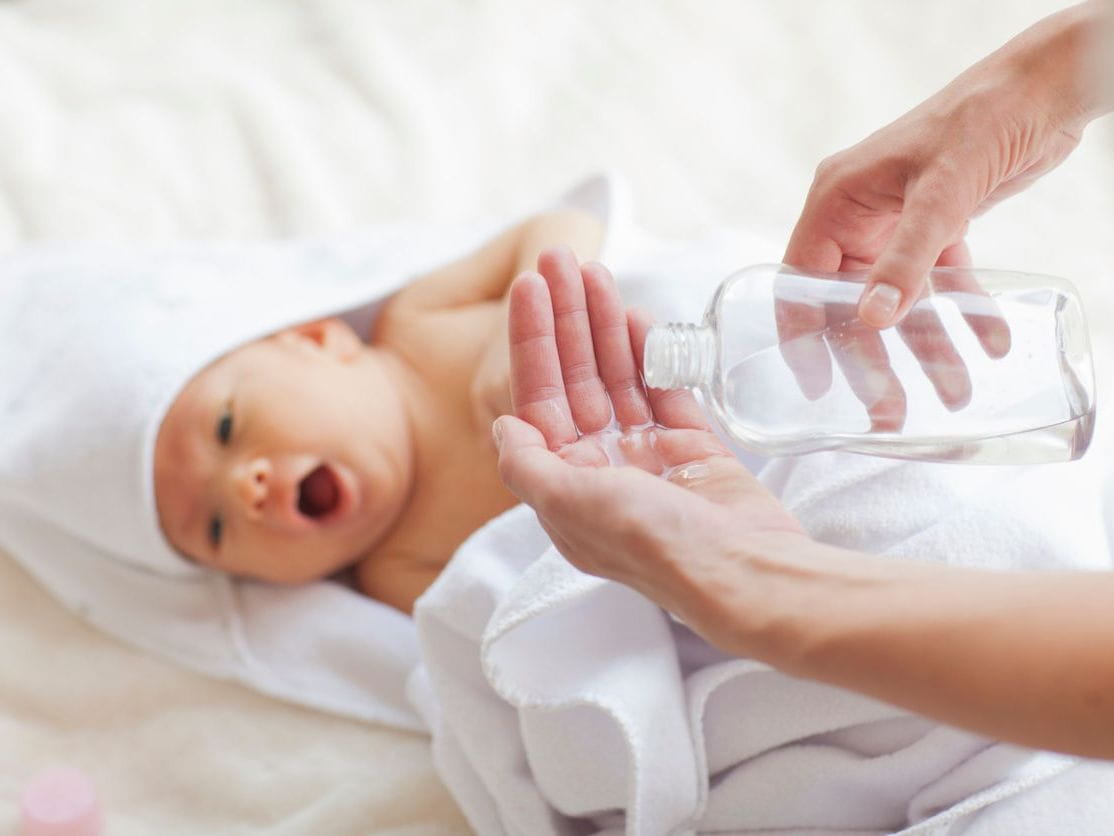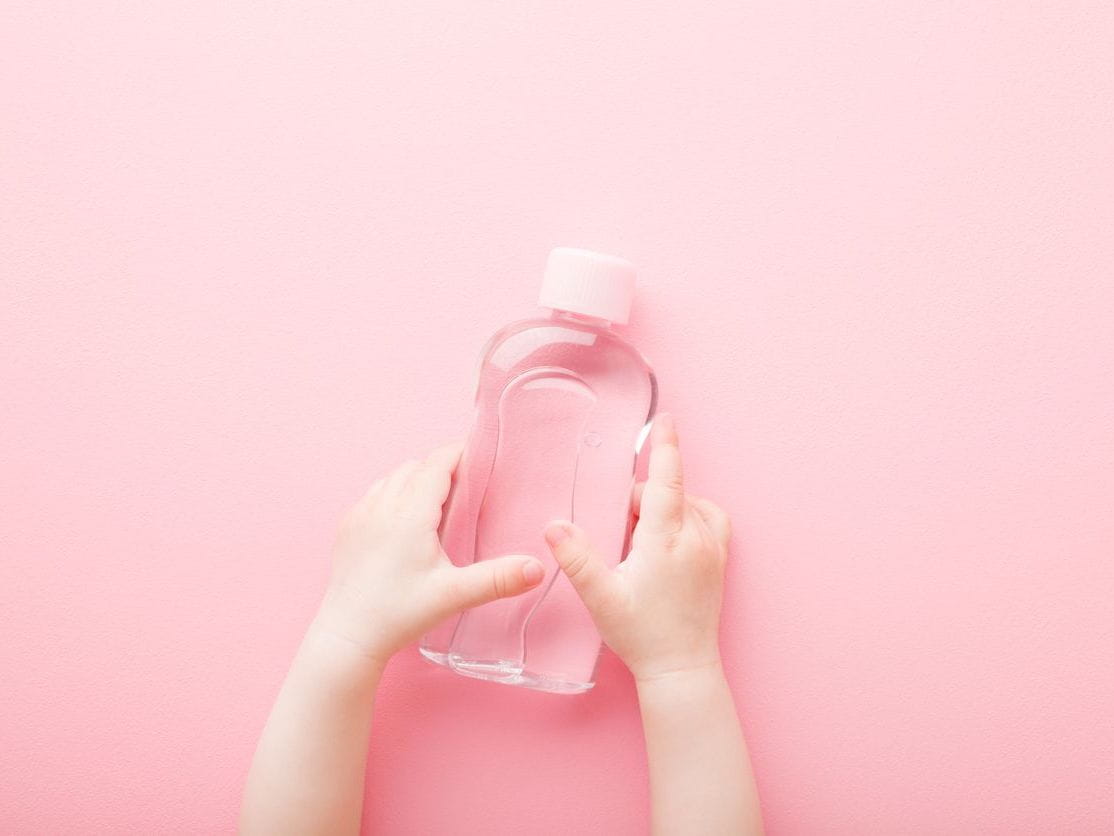Is Baby Oil Safe?

The Bottom Line
Baby oil contains mineral oil, which is odorless, colorless, and tasteless. Its main use is to moisturize the skin and keep it soft. Ingestion of baby oil is usually minimally toxic, but can cause diarrhea. A more serious complication is aspiration pneumonia, which occurs if baby oil is breathed into the lungs when swallowed.

Baby oil ingredients: What is baby oil made of?
Baby oil is made of mineral oil, either with or without fragrance. Mineral oil is a hydrocarbon refined from petroleum, and is an odorless, colorless, and tasteless oil.Baby oil, mineral oil, cooking oil, and motor oil: What are the differences?
Mineral oil and baby oil are basically the same; baby oil is a light mineral oil. They are distillates of petroleum, and are therefore not edible. Motor oil is another example of a petroleum distillate. It is not edible and not intended for use on the skin. Cooking oils such as olive oil, vegetable oil, and canola oil are edible oils that are derived from plants. For example, canola oil is derived from the seeds of the canola plant. Cooking oils are greasier and heavier. They can also be used on the skin safely.What is baby oil used for?
Baby oil is used by people of all ages to moisturize their skin and keep it soft. It can be used on the face and elsewhere on the body, but it may worsen acne in acne-prone people. It is sometimes used as a massage oil. A small amount can be used in the hair to keep it smoother. It is not recommended to use baby oil every day on baby’s skin unless it becomes dry and cracked.Can I put baby oil in my ear?
A few drops of warmed baby oil can be put in the ear to soften ear wax. Do not put baby oil in the ear if you have an ear infection.Is it okay to put baby oil on your lips?
It is okay to put baby oil on your lips for the treatment of chapped dry lips.Is baby oil toxic if ingested?
Ingestion of baby oil is usually minimally toxic. It acts as a laxative and can be taken by mouth in small amounts for the treatment of constipation. Gastrointestinal effects include diarrhea, nausea, and vomiting. A less common but more serious adverse effect of ingesting baby oil is aspiration pneumonia, which occurs if baby oil (or another fatty substance) is breathed into the lungs when it is swallowed.The toxicity of various oils is usually a function of their viscosity. Viscosity is a measure of how thick an oil is. Oils with high viscosity (e.g., motor oil) are less toxic than oils with low viscosity (e.g., baby oil) because low-viscosity oils are thinner, more slippery, and have a higher risk of being breathed into the lungs when swallowed (i.e., aspiration). Aspiration pneumonia is a serious and possibly life-threatening condition. Symptoms of aspiration include coughing and choking. Fever and difficulty breathing may develop over several hours.
Does baby oil have alcohol in it?
Baby oil does not contain drinking alcohol (i.e., ethanol). Some baby oils have propylene glycol, a type of alcohol, to make them smoother. Other possible additives include fragrances, parabens (a preservative), and dyes. When applied to the skin, some people experience allergic reactions to these other ingredients.What should I do if baby oil gets in my child’s eyes or mouth?
If baby oil gets into your child’s mouth, rinse out the mouth. No other treatment is needed if your child is not coughing or choking. If your child experiences coughing, choking, and/or fever, seek medical attention. Watch for diarrhea, which may take up to 8 hours to develop. If baby oil gets into your child’s eyes, rinse the eyes with water for at least 15 minutes. Since oil does not mix well with water, it may be harder to remove from the eye when rinsing with water, so you may need to rinse for a longer period.If someone swallows baby oil, gets baby oil in the eyes, or if you have a question about using baby oil safely, help from experts is available through the webPOISONCONTROL online tool and by phone at 1-800-222-1222. Poison Control’s expert guidance is always free, confidential, and available 24 hours a day.
Wendy Klein-Schwartz, Pharm.D., MPH
Clinical Toxicologist
Poison Control Media Information
Did you find this page helpful? If so, we need your support. Poison Control is in constant competition with misinformation online. Links to www.poison.org or our webPOISONCONTROL triage tool from other websites and blogs help internet searchers quickly find accurate information and Poison Control’s contact information in an emergency. If you use the content from this page, please provide attribution via a link back to this page, www.poison.org, or https://triage.webpoisoncontrol.org/#!/exclusions. By doing so, you could save a life. Thank you!
Poisoned?
Call 1-800-222-1222 or
Prevention Tips
- Store baby oil up, away, and out of sight of children.
- When using baby oil on a child, don’t put it down and turn your back. It takes only a second for a child to grab the bottle and take a drink.
- Using fragrance-free, dye-free baby oil products is preferred.
- Be cautious about using baby oil on acne-prone areas of the body.
This Really Happened
An 18-month-old child grabbed the bottle of baby oil off the changing table and swallowed an unknown amount. He immediately experienced coughing and choking. His mom called the poison center and was instructed to call 911 to take him to the hospital. In the emergency room, he had mild respiratory distress with an increased rate of breathing and episodes of coughing. Oxygen saturation in his blood was below normal and a chest x-ray showed an infiltrate in the right upper lobe of the lung. He was admitted to the hospital. Respiratory distress persisted and he developed a fever and elevated heart rate. Treatment was supportive including inhaled oxygen. His symptoms resolved slowly. After several weeks, he was discharged from the hospital despite an improved, but not completely normal, chest x-ray. He was followed post-hospitalization by his pediatrician and remained well.References
Jolliff HA, Fletcher E, Roberts KJ, Baker SD, McKenzie LB. Pediatric hydrocarbon-related injuries in the United States:2000-2009. Pediatrics. 2013;131:1139-1147. doi: 10.1542/peds.2012-3913.
Rajagopala S, Selvam N. An unusual cause of respiratory distress. J Postgrad Med. 2019;65(1):38-40. doi: 10.4103/jpgm.JPGM_496_17.
Reyes de la Rocha S, Cunningham JC, Fox E. Lipoid pneumonia secondary to baby oil aspiration: a case report and review of the literature. Pediatr Emerg Care. 1985;1(2):74-80.
Poisoned?
Call 1-800-222-1222 or
Prevention Tips
- Store baby oil up, away, and out of sight of children.
- When using baby oil on a child, don’t put it down and turn your back. It takes only a second for a child to grab the bottle and take a drink.
- Using fragrance-free, dye-free baby oil products is preferred.
- Be cautious about using baby oil on acne-prone areas of the body.
